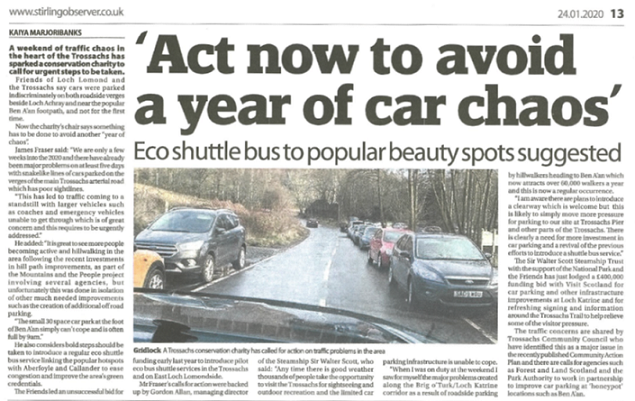
On 16th December, just before the “dead” holiday period the Loch Lomond and Trossachs National Park launched a six week consultation on a new Outdoor Recreation Plan (ORP). The consultation closes at 5pm today (see here to respond). Mary Jack, earlier this month, considered the discussion at the Board Meeting prior to the consultation launch, progress on the last Plan (which ended 3 years ago in 2017) and explained how this is not a plan at all, being devoid of action and firm commitments (here). This post takes a further look at what the draft “plan” says about the Loch Lomond and Trossachs National Park Authority’s support for outdoor recreation.
Outdoor recreation in Parkspeak
The consultation document (see here) is full glossy pictures, diagrams and phrases which sound good but are often devoid of meaning or divorced from reality. This starts with the title to the document:
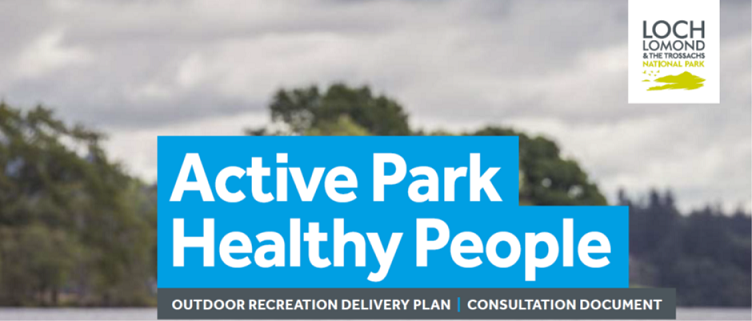
Parks, whether National, Regional, Country, town or village cannot be active, only people are. The main heading is therefore gobbledegook but the words “Active”, “Healthy” and “People” tick lots of Scottish Government boxes.
The sub-heading is, I am afraid, just a lie. This is yet another guidance document, which regurgitates mounds of government policy and sets out some vague “strategic” aspirations but without any clear actions to deliver this. This is confirmed by the following:
“Specific action plans will be developed by partners to deliver on the ambitions set out in this plan”.
Nothing now, its all in the future. The LLTNPA itself commits to no actions. Nor does it make any reference to all the uncompleted actions from the last Outdoor Recreation Plan which could and should have provided the basis for the new “plan”. Instead it asks:.
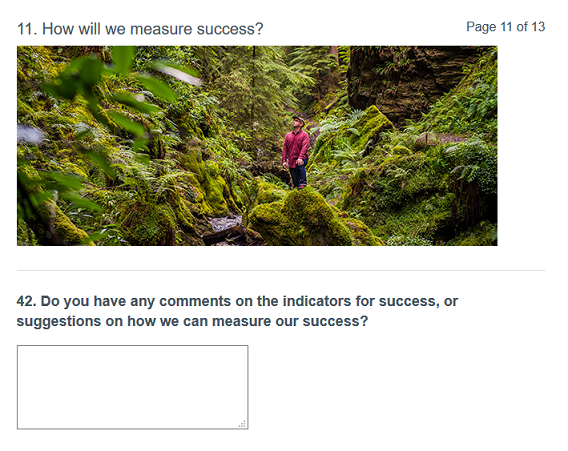
Its very difficult to know what to measure when nothing is actually proposed! Note too the spin. Indicators shouldmeasure both success and failure, as the last Plan did, but in the brave new world of the LLTNPA only success is allowed. It rather confirms the LLTNPA itself is a total failure!
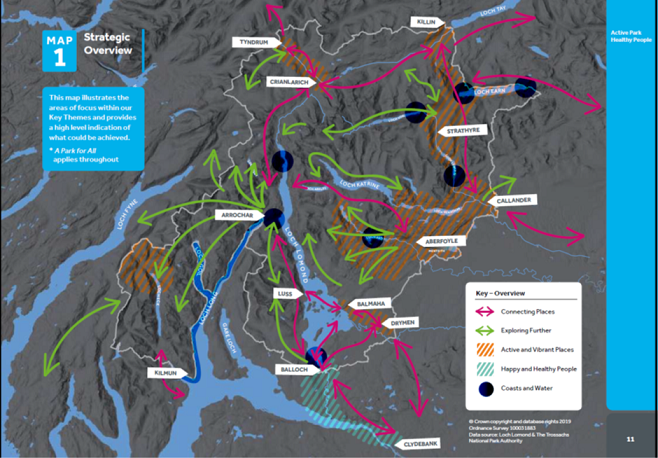
Understand this map? If you think you do, just compare it to the other maps and statements in the document. This “strategic overview” then falls apart. For example, the West Highland Railway line to Tarbet isn’t shown on this map yet in the report that are a couple of paragraphs outlining the exciting opportunities it might offer…….err, to improve connections.
The map suggests LLTNPA is not interested in connecting people to Cowal, the forgotten corner of the National Park reigned over by Forest and Land Scotland, even though other maps show there are opportunities for mountain biking and water sports there. Never mind though, its a very glossy piece of artwork.
Besides the photos and diagrams, the “plan” contains copious amounts of management speak:
“The emerging whole system approach to improving public health from Public Health Scotland is strongly supported.”
Do you know what this means?
Or how about this triumph of marketing:
“There is also an opportunity to re-establish new heritage routes in the National Park where they
link into the wider recreation network”.
Never mind that opportunities are meaningless unless they result in action, what does it mean to “re-establish” something which is already there? And surely “new heritage routes” are a contradiction in terms?
Unfortunately, parkspin appears destined to continue as one of the firmer suggestions in the “plan” is:
“an Ambassador Programme, driven in partnership, which could create a public-facing team of ambassadors from diverse backgrounds, ages and of diverse characteristics, including the National Park Youth Committee. The aspiration is that this team could connect with all who currently, or could, enjoy and value outdoor recreation in the National Park and can help stakeholders celebrate the National Park, promote new initiatives and help share successes and challenges far and wide”
“Driven in partnership” ? More meaningless management speak. A team that will connect with ALL who CURRENTLY enjoy the National Park – that’s about 4 million visitors a year – or COULD enjoy the National Park, let’s say another 4 million – really?? Fantasy land, but then the LLTNPA clearly needs something to replace their Ranger Service which used to provide this function but is now mainly devoted to policing the camping byelaws.
The real issues that need to be tackled
The omissions in the document are far more telling than what is included.
Camping/campervanning
With all the debate at present going on about campervans and tourism (see here), you might be surprised to learn that there is not a single reference to campervans or motorhomes in the entire document. There is one reference in a diagram to the camping development framework – note a framework, not a plan – agreed by the Board in March 2019. There is no analysis of what infrastructure is needed for camping and campervanning if it is to support the types of outdoor recreation which the LLTNPA claims it wants to encourage, let alone any plans.
Roads and public transport
“Within the National Park we [“We” is defined near the start of the “plan” as all delivery partners] can most effectively play our part by promoting and celebrating the multiple benefits of active and low-carbon journeys within the rural environment of this special landscape”
Those of us who enjoy outdoor recreation and try to use public transport, where it exists, don’t need anyone to celebrate for us the multiple benefits of low carbon journeys. We need more trains and buses, just like the people who live in the National Park, tourists or those who need to travel through. Improved public transport is the number one demand from the LLTNPA’s “Youth Committee”. James Stuart, the Park Convener, has twice said to the young people representing that “committee” at Board Meetings say that the Park will be judged on how it delivers on their demands. The absence of any practical proposals to improve public transport beyond what is already in the pipeline suggests the LLTNPA has failed on this before its even started.
At the time the National Park was created the then Mountaineering Council of Scotland, of which I was a member, made a number of practical suggestions for how public transport could be improved and car parking pressures could be relieved, including for example the establishment of a minibus service on the road to Rowardennan. The plan does refer to the parking chaos in Balmaha (but not at Ben A’an – see photo above) albeit in further parkspeak:
“Some other popular locations, such as Balmaha, are unfortunately now suffering from negative
peak period issues associated with high volumes of visitors arriving by car. It is crucial that places and transport infrastructure are designed to offer active and low carbon options to cope with increased numbers and protect the environment.”
This is not unfortunate, its a fundamental failure of the LLTNPA to do what it was set up to do yet still nothing is proposed. A minibus service from Drymen or Balmaha would make it possible for every young person in the Glasgow area to walk up and down Ben Lomond, the Park’s most famous hill and an outstanding viewpoint. Meantime, the contrast with places like the Alps is stark. There in the last 20 years, in both winter and summer, whether in a National Park or not, such schemes have become commonplace.
Funding for paths and the extent of the path network
Paths are crucial for outdoor recreation and – whether you agree with the spin or not – for the delivery of the LLTNPA’s stated ambitions. The “plan” refers to the work done by the Mountains for People project on paths over the last five years but says nothing about what will happen now that funding is coming to an end. The fact is that apart from funding for cycle paths from Sustrans, there is now NO core funding available either to create new paths or maintain existing ones. That probably partly explains why the Park’s Core Paths Plan was so lacking in ambition (see here) but leaves an enormous hole. So, why has the “plan” not addressed this? And what, for example, is Forestry and Land Scotland going to invest to make up the difference?
More specifically, while there is a reference to the West Highland Way in a section on the Park’s aspirations – note not plans – for Scotland’s “Great Trails”:
“Partners with an interest in the West Highland Way are developing new governance, monitoring and maintenance systems and capital investment programmes”
Sounds good doesn’t it unless you know that the LLTNPA has long been the lead authority for the West Highland Way and has been sitting on a report (obtained through FOI) on what investment is needed for three years this January. That, doesn’t exactly inspire confidence. Instead of tackling issues, the LLTNPA is sweeping them under the carpet and hoping no-one notices.
Infrastructure for watersports
While the “plan” does acknowledge the need to improve infrastructure for watersports under the final theme of Coasts and Water – another box ticked in Scotland’s Year of Coasts and Waters 2020 – there is not a single concrete proposal. There is also no reference let alone analysis of why, in the last Outdoor Recreation Plan, the area where least progress was watersports infrastructure let alone the role that the LLTNPA played in cutting infrastructure in places like Milarrochy (see here).
Outdoor education
Given all the parkspeak about diversity and inclusion, its pretty staggering there is not one mention of the role of Outdoor Education – or Outdoor Learning – in the document. Yes, not a single mention of the outdoor education centres that have managed to survive in and around the National Park after all the cuts nor any reference to the challenges that those that have survived face. Arguably, the most effective single means that could be adopted to ensure people from all backgrounds got to enjoy the National Park would be to re-instate Outdoor Centres and the old policy of Strathclyde Regional Council. Under this all children got a week in an outdoor centre in both primary and secondary schools. Perhaps the abolition of what was effectively a universal right to outdoor education has contributed to the educational attainment gap between rich and poor but hey, its far easier to talk about ambitions and aspirations than address the issues which matter.
Litter
Despite the litter problem getting worse (see here) there is not a single mention of litter in the document. Nor is there any mention of litter in the lengthy Habitat Regulations Appraisal which assesses the likely impact of increased outdoor recreation on all the protected “European” sites in the National Park. That rather confirms what I have always argued, that the impact of outdoor recreation in terms of litter and the natural environment is small compared to other human activities.
If, however, the LLTNPA was to admit this explicitly in the Outdoor Recreation Plan, there would be no justification left for the camping byelaws.
Countryside Rangers
There is not a single reference to the Countryside Ranger Service, the largest in Scotland! Supporting Outdoor Recreation used to be their raison d’etre but the LLTNPA have tried to turn them into a quasi police force to enforce the camping and water byelaws.
Confusion about inclusion
The headline to the news release announcing the Outdoor Recreation Plan stated:
“Views sought on plan to help more people get active in Scotland’s first National Park” (see here).
and goes on to say:
“Active Park, Healthy People sets out the ambitions of the National Park Authority and its partners for getting more people, more active, more often.
This is the same National Park Authority which has done more than any public authority in Scotland to stop younger people and people with less money from getting out and enjoying the countryside through its camping byelaws. So how do the camping byelaws fit with the Outdoor Recreation Plan? I don’t think they do, which is why the “plan” says nothing about them (or the Ranger Service – see above).
That doesn’t stop the document making lots of fine sounding noises about the need for social inclusion or how to enable “everybody” to enjoy outdoor recreation in the National Park.
Unfortunately, the plan almost immediately shoots itself in the foot through restricting its scope to exclude many activities:
“While outdoor recreation covers a vast range of activities, this plan particularly focusses on self-propelled mass participation activities such as walking, cycling, paddle sports and swimming to achieve the greatest health and inclusion gains. While the plan does not cover other activities such as fishing and boating, we recognise the role and value that all outdoor recreation has in encouraging people to spend time outdoors”.
Cycling and paddle sports are not cheap, hillwalkers tend, as the “plan” recognises, to be better off and most swimming, as opposed to quick dips, takes place through events – again not cheap. This was recognised at the December Board Meeting where there was a discussion about setting up more places where people could hire equipment for these activities. Couple the costs of these activities with the expense of getting to the National Park – which lots of people simple can’t afford – and you have enormous structural barriers which prevent a large part of the population from being able to enjoy the National Park.
Instead of identify this fundamental issue, the plan makes a number of token gestures towards excluded groups before reaching this conclusion:
“The number of people participating in an activity can be a misleading measurement of success and can potentially even lead to an increase in inequality. This plan is committed to helping the inactive to become active and the indicators on page 49 will ensure that we deliver for under-represented groups and new audiences.”
While “indicators” won’t ensure anything, the thinking here comes very close to saying that it might be better for the LLTNPA to reduce the overall number of people coming to the National Park – and make the population as a whole more inactive – in order to meet its equality objectives for under-represented groups!
The focus of the strategy is also on physical health, rather than mental health, although the two are obviously connected. The point is that its not just ACTIVE outdoor recreation which helps improve people’s mental well being. Activities excluded from the strategy, such as boating and fishing, have an absolute crucial role to play in people’s mental health. Confusingly, under the Coasts and Waters theme, there is a section on “blue health” or the beneficial effects people get just by being by the sea or loch shores.
As an illustration of this, I have been in contact with one person who lived for fishing on one of the lochs in the National Park. It gave meaning to his life outside work. The camping byelaws stopped him from doing what he loved. The result? He basically had a mental breakdown, lost his job and took a year to recover. So much for social inclusion. The LLTNPA should stop focussing and become a National Park for all. Unfortunately at present it is part of the problem, not the solution.
The manipulation of the consultation
As if all the propaganda is not enough, the only way to respond to the ORP “consultation” is to respond to fixed questions on an online survey:
.“How to respond to this consultation
Click ‘Next’ at the bottom of each page to navigate through the consultation. If any questions are marked with an * then you must provide an answer”
If you try to avoid a question you can’t even go to the next one to see what is being asked:
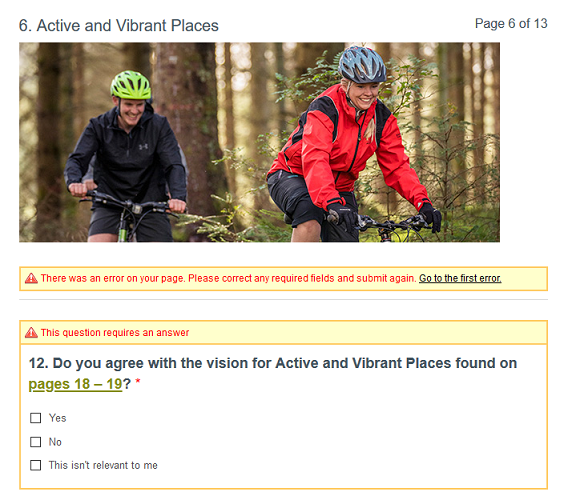
You therefore have no control over what you might want to respond to. The online questionaire forces each respondent to answer three questions for each of the six themes in the plan: do you agree with the vision; do you agree with the focus areas/delivery principles; and has the LLTNPA identified the right delivery partners? If you get through that, you can skip the question on measures for success, and get to the crucial little box at the end that asks if you have any other comments.
Each time the LLTNPA does a consultation, the questions seem to become more directive and more restrictive. How this fits with the National Standards on Community Engagement (see here) or the appointment of Sarah Drummond, now a “Dr”, to the Board to advise on communications I am not sure. What I do know is I have never across a consultation which makes it so hard for the public to comment freely – its even worse than the consultation on the Trees and Woodland Strategy last year. It will be interesting to see how many critical responses are received and how the LLTNPA deals with these.
Instead of trying to manipulate consultation responses by setting out all the questions and limiting how people can respond, the LLTNPA should go back to an almost blank sheet of paper/screen headed with just one question: “What do you think of this Plan?” That would be far more likely to lead to real, rather than tick box, consultation and engagement.
Responsibility for the LLTNPA’s outdoor recreation failures
The Access Team who nominally produced this draft plan are not, I believe, responsible for it being unfit for purpose. My suspicion is that they were told not to include any definite actions because this would highlight the need for investment and the LLTNPA doesn’t want to be seen as failing to achieve its targets in future, as happened in the last plan. It also appears that they have been forbidden to talk to the Ranger Service because how else could you explain why this is not mentioned in the “plan”?
Cut through the parkspeak, however, and there are indications in the “plan” that there are staff in the LLTNPA who still know what they are talking about and believe that things like public transport, paths and infrastructure for watersports are important, its just that they are reduced to expressing these as aspirations rather than plans.
Responsibility for another “delivery plan” that will deliver nothing intentionally lies the LLTNPA’s senior management and Board. They are not prepared to say anything about the investment that is really needed in the National Park to support Outdoor Recreation and enable far more people to participate. The reason? This would highlight the collapse of public services in Scotland. The LLTNPA’s plan can be summarised as picking up any financial windfalls that fall its way but otherwise sit by and wait.
Its time that Board Members once again discussed (see here) what they are there for.
Again well done Parkwatch for all your information and hard work
I, as a park resident, read this ‘Plan’ a couple of weeks ago when it was brought to my attention. The conclusion I came to was exactly same, summarised as: a load of pretentious management speak illustrated with fancy graphics that means absolutely nothing, in practice. Having decided to respond with comments to this effect, I gave up after the first question as one, I had no idea what it was asking and two, the answer options were too restrictive and vague. This is not a valid way of analysing feedback as most people will agree with the principles laid out in the plan, but they are so vague, there is no indication of what they will actually result in. Nowhere in the plan are specific projects identified or information provided on what supposed ‘improvements’ are in the pipeline. No doubt more sanitisation of the countryside and upgrading (ie ruination) of perfectly adequate footpaths (a great example of which is stated within the plan – the Strathayre to Callander route).
Totally agree with your assessment….. plenty of fudge, no resources and no leadership.
This plan cost lots of money your dam right we’ll manipulate feedback we always do and the Scottish government laps it all up like usual total suckers